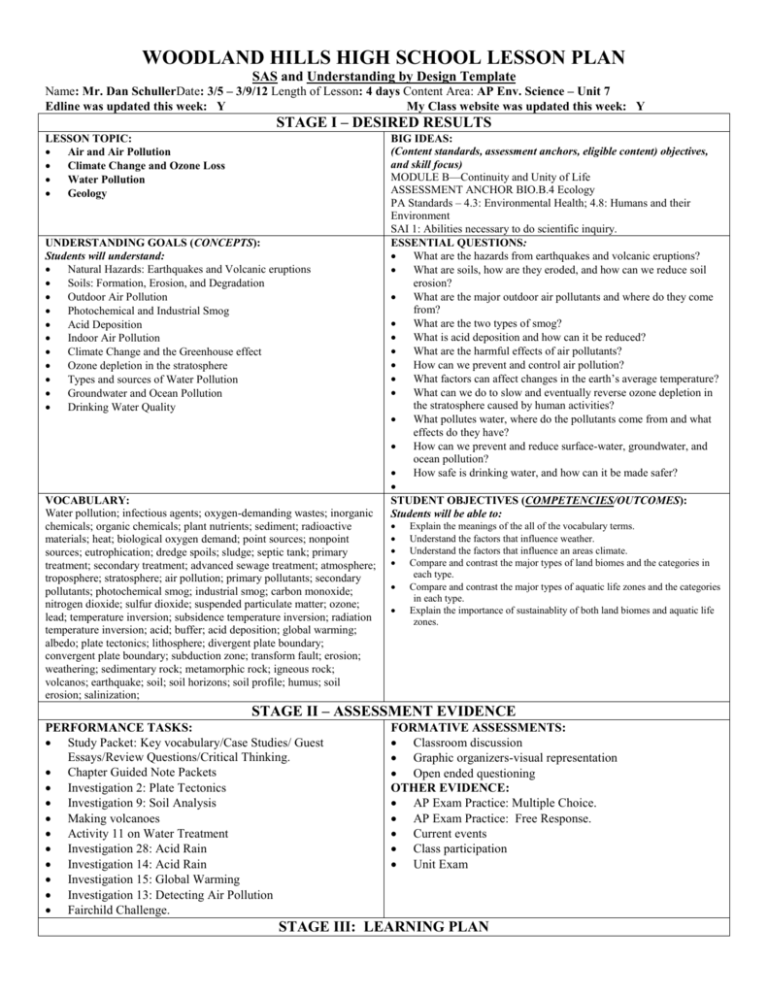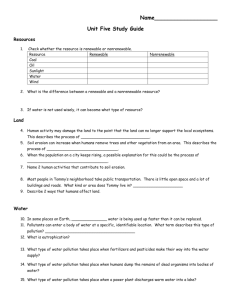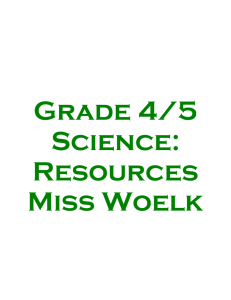student objectives (competencies/outcomes)
advertisement

WOODLAND HILLS HIGH SCHOOL LESSON PLAN SAS and Understanding by Design Template Name: Mr. Dan SchullerDate: 3/5 – 3/9/12 Length of Lesson: 4 days Content Area: AP Env. Science – Unit 7 Edline was updated this week: Y My Class website was updated this week: Y STAGE I – DESIRED RESULTS LESSON TOPIC: Air and Air Pollution Climate Change and Ozone Loss Water Pollution Geology UNDERSTANDING GOALS (CONCEPTS): Students will understand: Natural Hazards: Earthquakes and Volcanic eruptions Soils: Formation, Erosion, and Degradation Outdoor Air Pollution Photochemical and Industrial Smog Acid Deposition Indoor Air Pollution Climate Change and the Greenhouse effect Ozone depletion in the stratosphere Types and sources of Water Pollution Groundwater and Ocean Pollution Drinking Water Quality VOCABULARY: Water pollution; infectious agents; oxygen-demanding wastes; inorganic chemicals; organic chemicals; plant nutrients; sediment; radioactive materials; heat; biological oxygen demand; point sources; nonpoint sources; eutrophication; dredge spoils; sludge; septic tank; primary treatment; secondary treatment; advanced sewage treatment; atmosphere; troposphere; stratosphere; air pollution; primary pollutants; secondary pollutants; photochemical smog; industrial smog; carbon monoxide; nitrogen dioxide; sulfur dioxide; suspended particulate matter; ozone; lead; temperature inversion; subsidence temperature inversion; radiation temperature inversion; acid; buffer; acid deposition; global warming; albedo; plate tectonics; lithosphere; divergent plate boundary; convergent plate boundary; subduction zone; transform fault; erosion; weathering; sedimentary rock; metamorphic rock; igneous rock; volcanos; earthquake; soil; soil horizons; soil profile; humus; soil erosion; salinization; BIG IDEAS: (Content standards, assessment anchors, eligible content) objectives, and skill focus) MODULE B—Continuity and Unity of Life ASSESSMENT ANCHOR BIO.B.4 Ecology PA Standards – 4.3: Environmental Health; 4.8: Humans and their Environment SAI 1: Abilities necessary to do scientific inquiry. ESSENTIAL QUESTIONS: What are the hazards from earthquakes and volcanic eruptions? What are soils, how are they eroded, and how can we reduce soil erosion? What are the major outdoor air pollutants and where do they come from? What are the two types of smog? What is acid deposition and how can it be reduced? What are the harmful effects of air pollutants? How can we prevent and control air pollution? What factors can affect changes in the earth’s average temperature? What can we do to slow and eventually reverse ozone depletion in the stratosphere caused by human activities? What pollutes water, where do the pollutants come from and what effects do they have? How can we prevent and reduce surface-water, groundwater, and ocean pollution? How safe is drinking water, and how can it be made safer? STUDENT OBJECTIVES (COMPETENCIES/OUTCOMES): Students will be able to: Explain the meanings of the all of the vocabulary terms. Understand the factors that influence weather. Understand the factors that influence an areas climate. Compare and contrast the major types of land biomes and the categories in each type. Compare and contrast the major types of aquatic life zones and the categories in each type. Explain the importance of sustainablity of both land biomes and aquatic life zones. STAGE II – ASSESSMENT EVIDENCE PERFORMANCE TASKS: Study Packet: Key vocabulary/Case Studies/ Guest Essays/Review Questions/Critical Thinking. Chapter Guided Note Packets Investigation 2: Plate Tectonics Investigation 9: Soil Analysis Making volcanoes Activity 11 on Water Treatment Investigation 28: Acid Rain Investigation 14: Acid Rain Investigation 15: Global Warming Investigation 13: Detecting Air Pollution Fairchild Challenge. FORMATIVE ASSESSMENTS: Classroom discussion Graphic organizers-visual representation Open ended questioning OTHER EVIDENCE: AP Exam Practice: Multiple Choice. AP Exam Practice: Free Response. Current events Class participation Unit Exam STAGE III: LEARNING PLAN INSTRUCTIONAL PROCEDURES: Power Point Notes/Class discussion Lab investigations Assignments (Class & Home) ACTIVE ENGAGEMENT USED: Note taking Partnering Concept sketches Case Studies SCAFFOLDING USED: Chunking Visual support Teacher Prompting DAY MINI LESSONS NUMBER/DATE TOPIC OBJECTIVE(S) By the end of the lesson each student will be able to: PROCEDURES / TECHNIQUES To reach objectives MATERIALS AND RESOURCES: Computer Computer projector Textbooks Folders Handouts Lab Materials CONTENT AREA READING: Chapter text Outside Reading Monday 2 3/5 Renewable Energy Sources DAY Tuesday 3 3/6 Renewable Energy DAY Wednesday 4 3/7 What’sup Wednesday ASSIGNMENTS: Chapter Study Packet Lab write ups/reports Lab investigation handouts. Case Studies AP Exam Practice: Multiple Choice. AP Exam Practice: Free Response. Current events. DAY 5 Thursday 3/8 Water DAY Friday 6 3/9 FRF/ Renewable Energy Lab. Evaluate the knowledge of the concepts covered in Chapter 15. Review the major types of renewable energy sources. Journal about a current environmental topic. Introduction to the unit on Water. Practice the free response section of the AP Exam. Build a wind turbine or a solar panel. Chapter 15 Test Modern Marvels: Renewable Energy Video. Journals. Class discussion Power Point notes on Water. Free Response Friday. Lab: Listen to the Saturday Light Brigade Radiocast. Questions for interview. Homework: INTERVENTIONS: Redirection during class. 1-to-1 assistance. Moving seat to a more productive location. After class/school tutoring. Corrections on assignment/exam. Extension to complete assignment. Conference with other staff. (Counselors or administrators) Conference with parent. Work on Fairchild Challenge #5. Video Sheet. Select group of students sharing current event articles. Lab: work on making a wind turbine or solar panel. Lab: Renewable Energy Video Work on Fairchild Challenge #5. Chapter 13 Study Packet.








